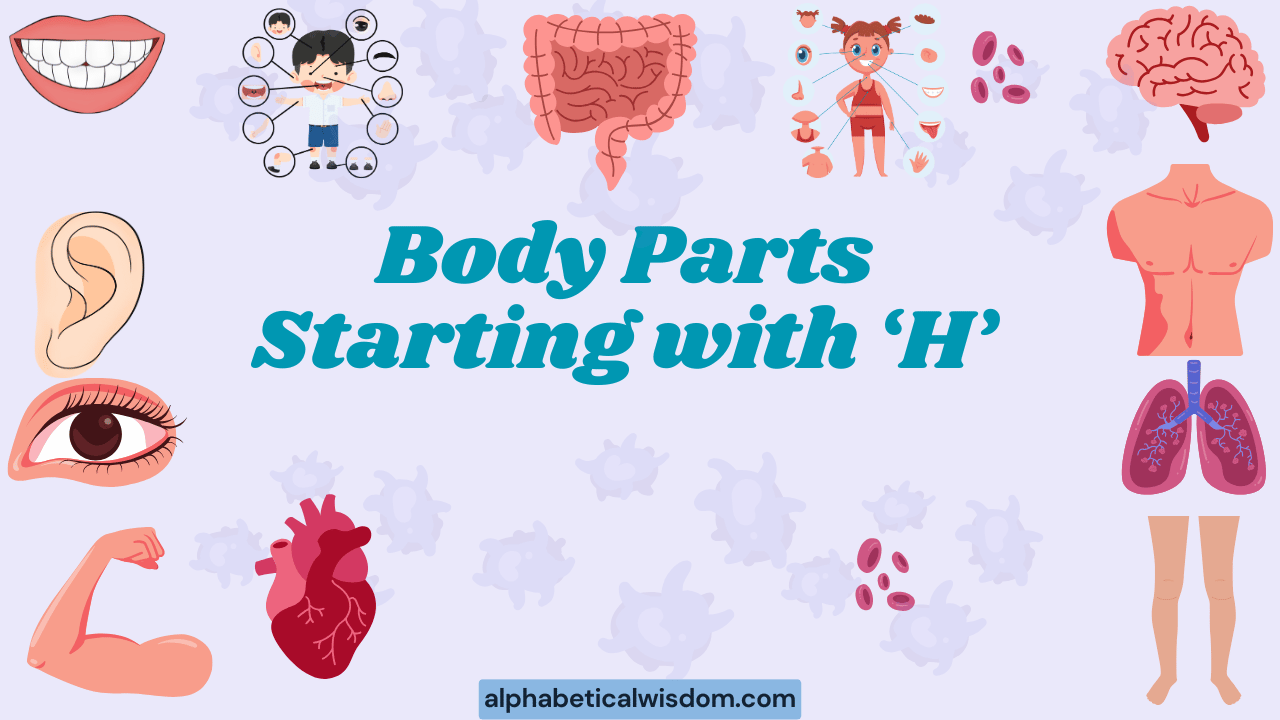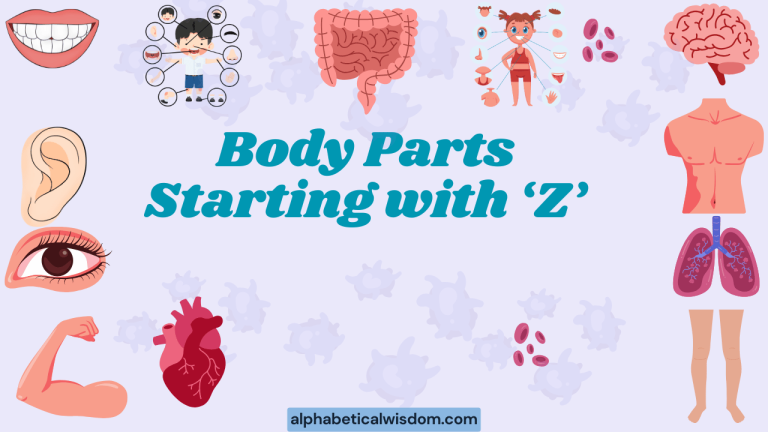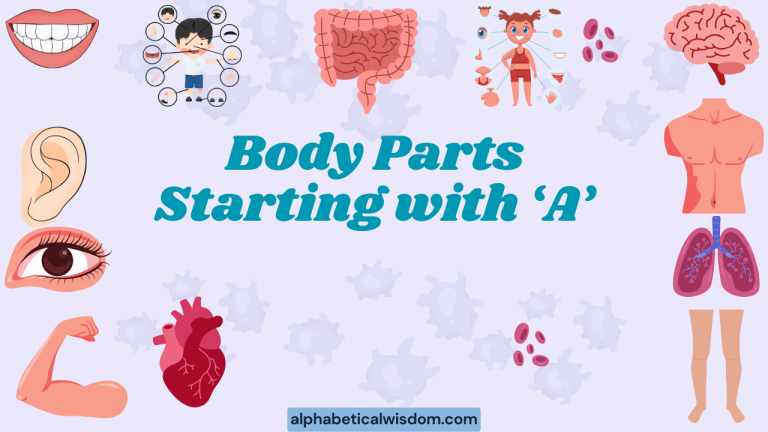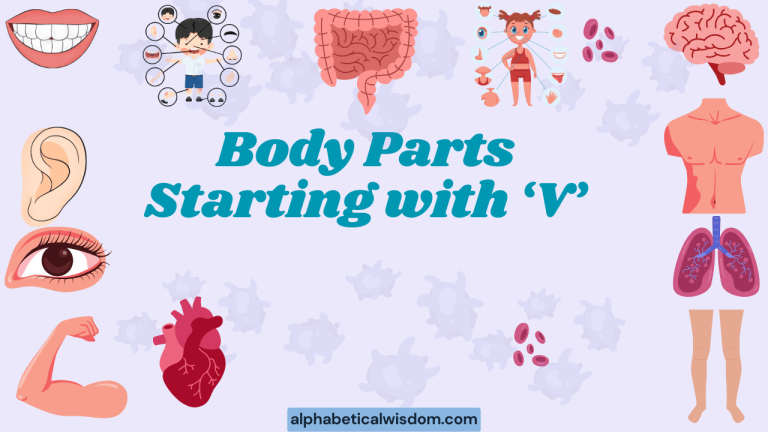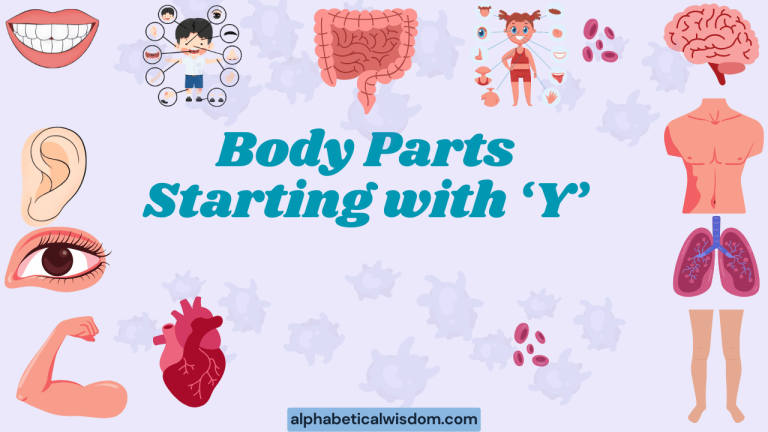Body Parts Starting with ‘H’: A Comprehensive Grammar Guide
Understanding the vocabulary related to body parts is essential for effective communication in English. Specifically, mastering the nouns that start with the letter ‘H’ enhances our ability to describe anatomy, discuss health, and express ourselves clearly in various contexts.
This guide provides a detailed exploration of these terms and includes examples, usage rules, and practice exercises. This article is designed for English language learners of all levels, healthcare professionals, and anyone interested in expanding their anatomical vocabulary.
Table of Contents
- Introduction
- Definition of Body Parts Starting with ‘H’
- Structural Breakdown
- Types and Categories
- Examples
- Usage Rules
- Common Mistakes
- Practice Exercises
- Advanced Topics
- FAQ
- Conclusion
Definition of Body Parts Starting with ‘H’
This section focuses on defining and explaining the various body parts whose names begin with the letter ‘H’. These terms are primarily nouns and refer to specific anatomical structures.
Understanding their individual functions and contexts is crucial for precise communication in medical, scientific, and everyday conversations.
These terms can be classified as anatomical nouns, referring to specific parts of the human body. Their function varies depending on the specific body part.
For example, the heart is vital for circulating blood, while the hand is essential for grasping and manipulating objects. The context in which these terms are used can range from medical diagnoses to casual descriptions.
Structural Breakdown
The structure of these terms is relatively straightforward. They are typically used as nouns, and they can be modified by adjectives to provide more detail.
For instance, we might say “a healthy heart” or “a strong hand.” They also frequently appear in prepositional phrases, such as “pain in the hip” or “hair on the head.”
These nouns follow standard English grammatical rules. They can be singular or plural (e.g., “hand” vs.
“hands”). They can also be used with articles (e.g., “the head,” “a heart”).
Their use in sentences generally aligns with the typical subject-verb-object structure of English.
Types and Categories
Here, we will categorize and explore each ‘H’ body part in detail.
Head
The head is the uppermost part of the human body, connected to the torso by the neck. It encloses the brain, eyes, ears, nose, and mouth. The head is crucial for sensory perception, thought, and communication.
Hair
Hair is a filamentous biomaterial that grows from follicles found in the dermis. Human hair serves various purposes: protection, sensory function, and thermoregulation. The appearance and characteristics of hair vary widely among individuals.
Hand
The hand is a prehensile multi-fingered extremity located at the end of the forearm or forelimb of primates. It is the chief organ for physical manipulation, providing fine motor skills and sensory feedback. The human hand has five digits: thumb, index finger, middle finger, ring finger, and little finger.
Heart
The heart is a muscular organ that pumps blood throughout the body via the circulatory system, supplying oxygen and nutrients to the tissues. It is located in the chest between the lungs. The human heart has four chambers: two atria and two ventricles.
Hip
The hip refers to the region around the hip joint, which connects the leg to the pelvis. It plays a critical role in movement, stability, and weight-bearing. The hip joint is a ball-and-socket joint, allowing for a wide range of motion.
Heel
The heel is the rounded prominence at the back of the foot. It plays a crucial role in walking, running, and maintaining balance. The heel bone (calcaneus) is the largest bone in the foot.
Humerus
The humerus is the long bone in the upper arm that extends from the shoulder to the elbow. It articulates with the scapula (shoulder blade) at the shoulder joint and with the radius and ulna (forearm bones) at the elbow joint. It provides structural support and facilitates movement in the upper limb.
Examples
This section will provide examples of how each ‘H’ body part is used in sentences.
Head Examples
The following table provides examples of how the word “head” is used in various contexts.
| Sentence | Context |
|---|---|
| She nodded her head in agreement. | Gesture |
| He has a bad headache. | Health |
| The company’s head office is in London. | Location |
| She is the head of the department. | Leadership |
| He couldn’t wrap his head around the problem. | Understanding |
| The ball hit him on the head. | Accident |
| She shook her head in disbelief. | Emotion |
| He has a good head for business. | Aptitude |
| Keep your head up! | Encouragement |
| He is ahead of the game. | Progress |
| Two heads are better than one. | Collaboration |
| He lost his head in the heat of the moment. | Impulsivity |
| The river’s headwaters are in the mountains. | Origin |
| He butted heads with his boss. | Conflict |
| She has a clear head. | Mental clarity |
| He turned his head to look. | Action |
| The project is the brainchild of the team head. | Innovation |
| He is over his head in debt. | Difficulty |
| She is head and shoulders above her peers. | Superiority |
| He put his head down and worked hard. | Diligence |
| The head teacher addressed the students. | Education |
| He has a big head. | Arrogance |
| She used her head to solve the problem. | Intelligence |
| He is always banging his head against the wall. | Frustration |
| The head of the nail was rusty. | Object detail |
Hair Examples
The following table provides examples of how the word “hair” is used in various contexts.
| Sentence | Context |
|---|---|
| She has long, brown hair. | Description |
| He needs a haircut. | Grooming |
| The wind blew her hair across her face. | Environment |
| She dyed her hair blonde. | Transformation |
| He found a hair in his soup. | Unpleasant discovery |
| She brushed her hair every morning. | Routine |
| His hair is starting to turn gray. | Aging |
| She wears her hair in a ponytail. | Style |
| He has thick hair. | Quantity |
| She styled her hair for the party. | Preparation |
| The dog is shedding hair. | Animal characteristic |
| He has a receding hairline. | Hair loss |
| She braided her hair. | Activity |
| His hair was neatly combed. | Appearance |
| She has beautiful, shiny hair. | Admiration |
| He ran his fingers through his hair. | Gesture |
| She used hairspray to keep her hair in place. | Product |
| He has a full head of hair. | Abundance |
| She got a perm in her hair. | Treatment |
| His hair is naturally curly. | Characteristic |
| She put a ribbon in her hair. | Accessory |
| He is pulling his hair out over the problem. | Frustration |
| She has layers in her hair. | Style detail |
| The texture of her hair is fine. | Quality |
| He shaved his head, leaving no hair. | Absence |
Hand Examples
The following table provides examples of how the word “hand” is used in various contexts.
| Sentence | Context |
|---|---|
| She held his hand tightly. | Affection |
| He raised his hand to ask a question. | Participation |
| The clock’s hand pointed to noon. | Object part |
| She wrote the letter by hand. | Method |
| He gave her a helping hand. | Assistance |
| She clapped her hands in excitement. | Emotion |
| He shook hands with the manager. | Greeting |
| She had a hand in the project’s success. | Influence |
| He played his hand carefully. | Strategy |
| She is skilled with her hands. | Ability |
| He asked for her hand in marriage. | Proposal |
| The artist’s hand was evident in the painting. | Style |
| She has the upper hand in the negotiation. | Advantage |
| He washed his hands before dinner. | Hygiene |
| She knows the subject like the back of her hand. | Familiarity |
| He had to lend a hand to finish the task. | Help |
| She tried her hand at pottery. | Attempt |
| He tipped his hand too early. | Premature action |
| She is a seasoned hand at this job. | Experience |
| He had the game in the palm of his hand. | Control |
| She kept her hand on the steering wheel. | Action |
| He was caught red-handed. | Guilt |
| She played her cards close to her hand. | Secrecy |
| He has a steady hand for surgery. | Precision |
| She gave him a round of applause with clapping hands. | Appreciation |
Heart Examples
The following table provides examples of how the word “heart” is used in various contexts.
| Sentence | Context |
|---|---|
| The doctor listened to his heart. | Medical |
| She has a kind heart. | Character |
| He poured his heart out to her. | Emotion |
| The heart of the city is bustling. | Location |
| She learned the poem by heart. | Memory |
| He followed his heart and pursued his dreams. | Passion |
| The team showed great heart in the competition. | Courage |
| She wears her heart on her sleeve. | Openness |
| He had a change of heart. | Decision |
| The heart of the matter is simple. | Essence |
| She put her heart and soul into the project. | Dedication |
| He has a heart of gold. | Generosity |
| The news broke her heart. | Sadness |
| He has a weak heart. | Health |
| She took the criticism to heart. | Sensitivity |
| He is the heart and soul of the team. | Importance |
| She has a heavy heart. | Sorrow |
| He lost heart after the setback. | Discouragement |
| She wears her heart on her sleeve. | Transparency |
| He spoke from the heart. | Sincerity |
| The heart pumps blood throughout the body. | Physiology |
| She hardened her heart to the situation. | Resilience |
| He has a lion’s heart. | Bravery |
| She followed her heart’s desire. | Aspiration |
| He has a cold heart. | Indifference |
Hip Examples
The following table provides examples of how the word “hip” is used in various contexts.
| Sentence | Context |
|---|---|
| She has pain in her hip. | Health |
| The baby sat on her hip. | Carrying |
| She broke her hip in the fall. | Injury |
| The skirt was tight around her hips. | Clothing |
| She swayed her hips to the music. | Movement |
| He has wide hips. | Description |
| The doctor examined her hip joint. | Medical |
| She placed her hands on her hips. | Attitude |
| The belt cinched in at her hips. | Fashion |
| He felt a twinge in his hip after the run. | Discomfort |
| She has a prosthetic hip. | Medical device |
| He stretched his hip flexors. | Exercise |
| The jeans fit snugly over her hips. | Clothing fit |
| She carried the bag on her hip. | Method of carrying |
| He felt a sharp pain in his left hip. | Specific pain |
| She exercises to strengthen her hip muscles. | Fitness |
| The dancers move their hips rhythmically. | Dance |
| He needs hip replacement surgery. | Medical procedure |
| She has a tattoo on her hip. | Body art |
| He leaned his hip against the wall. | Posture |
| The swimsuit accentuated her hips. | Appearance |
| She felt a pop in her hip during the workout. | Physical sensation |
| He has arthritis in his hip. | Medical condition |
| She used a cane to support her hip. | Assistive device |
| The bones of the hip protect vital organs. | Protection |
Heel Examples
The following table provides examples of how the word “heel” is used in various contexts.
| Sentence | Context |
|---|---|
| She wore high heels to the party. | Fashion |
| He has a blister on his heel. | Health |
| The dog nipped at his heels. | Animal behavior |
| She dug her heels in and refused to cooperate. | Resistance |
| The shoe rubbed against her heel. | Discomfort |
| He kicked up his heels and celebrated. | Joy |
| She walked on her heels. | Posture |
| He landed hard on his heel. | Impact |
| The boot had a sturdy heel. | Footwear |
| She felt pain in her heel after the run. | Discomfort |
| He has a cracked heel. | Skin condition |
| She stretched her Achilles heel. | Exercise |
| The heel of the loaf was stale. | Food |
| He wore shoes with a rubber heel. | Material |
| She needed to replace the heel on her shoe. | Repair |
| He walked heel-to-toe. | Balance |
| She stepped on his heel accidentally. | Accident |
| He put lifts in his shoes to raise his heel. | Modification |
| She has calluses on her heels. | Skin condition |
| He stubbed his heel on the curb. | Incident |
| She massaged her tired heels. | Relaxation |
| He scraped his heel on the pavement. | Injury |
| She wore open-heeled shoes. | Style |
| He has a bone spur on his heel. | Medical condition |
| She slipped on the ice and landed on her heel. | Accident |
Humerus Examples
The following table provides examples of how the word “humerus” is used in various contexts.
| Sentence | Context |
|---|---|
| He fractured his humerus in the accident. | Injury |
| The doctor examined his humerus. | Medical |
| The humerus is the long bone in the upper arm. | Anatomy |
| She felt pain in her humerus after the workout. | Discomfort |
| The X-ray showed a break in the humerus. | Diagnosis |
| He strengthened his humerus with weightlifting. | Exercise |
| The humerus connects the shoulder to the elbow. | Anatomical connection |
| She underwent surgery to repair her fractured humerus. | Medical procedure |
| He felt a sharp pain in his humerus. | Specific pain |
| The humerus is essential for arm movement. | Function |
| She has a bone tumor in her humerus. | Medical condition |
| He dislocated his humerus at the shoulder joint. | Injury |
| The humerus articulates with the scapula. | Anatomical articulation |
| She received physical therapy for her humerus injury. | Rehabilitation |
| He stretched the muscles around his humerus. | Exercise |
| The humerus provides structural support to the arm. | Support |
| She has a hairline fracture in her humerus. | Specific type of injury |
| He strengthened his arm muscles, including those attached to the humerus. | Muscle strengthening |
| The humerus is vulnerable to fractures in contact sports. | Risk factor |
| She had a bone density scan to check the health of her humerus. | Medical test |
| He used a sling to immobilize his humerus after the surgery. | Immobilization |
| She worked with a physical therapist to regain full function of her humerus. | Rehabilitation |
| The humerus is protected by surrounding muscles and tissues. | Protection |
| He felt a throbbing pain deep within his humerus. | Pain Description |
| She was diagnosed with osteomyelitis in her humerus. | Infection |
Usage Rules
When using body parts starting with ‘H’, there are a few rules to keep in mind. First, ensure correct spelling.
Second, use the appropriate article (a, an, or the) depending on the context. Third, be mindful of whether the body part is singular or plural.
For example, you would say “I have a headache,” not “I have headache.” Similarly, “The heart is a vital organ,” not “Heart is a vital organ.” When referring to multiple hands, use the plural form: “She washed her hands.”
Common Mistakes
One common mistake is confusing “hair” (the noun referring to strands of hair) with “hare” (a type of rabbit). Another is misspelling common words like “head” or “heart.” Additionally, learners may sometimes misuse articles with body parts, such as saying “I hurt head” instead of “I hurt my head.”
Here are some examples of common mistakes and their corrections:
| Incorrect | Correct |
|---|---|
| I have headache. | I have a headache. |
| She hurt head. | She hurt her head. |
| The hairs are brown. | Her hair is brown. |
| He broke hip. | He broke his hip. |
Practice Exercises
Test your understanding with these exercises.
Exercise 1
Fill in the blanks with the correct body part starting with ‘H’.
| Question | Answer |
|---|---|
| He wears a hat on his _____. | head |
| She has long, flowing _____. | hair |
| He shook her _____. | hand |
| The _____ pumps blood around the body. | heart |
| She has pain in her _____. | hip |
| She wore high _____ to the party. | heels |
| He fractured his _____. | humerus |
| He is pulling his _____ out because of stress. | hair |
| She rests the baby on her _____. | hip |
| He felt a sharp pain in his _____. | heel |
Exercise 2
Correct the following sentences if they are incorrect.
| Question | Answer |
|---|---|
| I have headache. | I have a headache. |
| She hurt head. | She hurt her head. |
| His hairs are long. | His hair is long. |
| The heart is vital. | Correct |
| She has a pain in hip. | She has a pain in her hip. |
| He broke humerus. | He broke his humerus. |
| She wears a ring on hand. | She wears a ring on her hand. |
| The heels hurt. | Correct |
| He is ahead. | He is ahead. |
| He has kind heart. | He has a kind heart. |
Advanced Topics
For advanced learners, consider exploring idiomatic expressions that use these body parts. For example, “to keep your head” means to stay calm, and “to be head over heels” means to be deeply in love.
Also, investigate the medical terminology associated with these body parts for a more in-depth understanding.
Another advanced topic is the etymology (origin) of these words. Understanding the historical roots of these terms can provide a deeper appreciation for the English language and its evolution.
Researching the Latin or Greek origins of anatomical terms like “humerus” can be particularly enlightening.
FAQ
- What is the plural form of “hand”?
The plural form of “hand” is “hands.” This is a regular plural, formed by adding ‘-s’ to the singular noun.
- How do I use “hair” correctly in a sentence?
“Hair” is usually treated as an uncountable noun, so use singular verbs with it. For example, “Her hair is brown,” not “Her hair are brown.” When referring to individual strands, you can say “hairs,” but this is less common.
- What’s the difference between “headache” and “head ache”?
“Headache” is the correct spelling for the noun referring to a pain in the head. “Head ache” is not a standard expression.
- When should I use “a” vs. “the” with body parts?
Use “a” when referring to a general instance of a body part (e.g., “I have a headache”). Use “the” when referring to a specific body part that has already been mentioned or is understood (e.g., “The heart is a vital organ”). Also, use possessive pronouns (my, your, his, her, its, our, their) before the body part (e.g., I hurt my head).
- Is it correct to say “I washed my hand”?
It is more common and grammatically correct to say “I washed my hands,” since we typically wash both hands. However, “I washed my hand” is correct if you are only referring to one hand.
- What does it mean to “lose your head”?
To “lose your head” is an idiom that means to become overwhelmed by emotions, especially anger or panic, and to act irrationally as a result.
- What is the medical term for “heel pain”?
The medical term for heel pain is “calcaneal pain” or “heel spur syndrome”, depending on the cause of the pain.
- How is the word “humerus” typically used in medical contexts?
In medical contexts, “humerus” is used to specifically refer to the bone in the upper arm, often in discussions of fractures, injuries, or anatomical descriptions. For example, “The X-ray revealed a fracture of the humerus.”
- What are some common idioms that use the word “heart”?
Some common idioms using “heart” include “to have a change of heart” (to alter one’s opinion or decision), “to wear your heart on your sleeve” (to openly display your emotions), and “to learn something by heart” (to memorize something perfectly).
Conclusion
Mastering the use of body parts starting with the letter ‘H’ is a valuable step in improving your English vocabulary and communication skills. By understanding the definitions, usage rules, and common mistakes associated with these terms, you can express yourself more accurately and confidently.
Continue to practice and expand your knowledge to achieve fluency in English.
Remember to review the examples provided and practice the exercises regularly. Pay attention to context and usage in real-life conversations and written materials.
With consistent effort, you will become more comfortable and proficient in using these essential English words.
